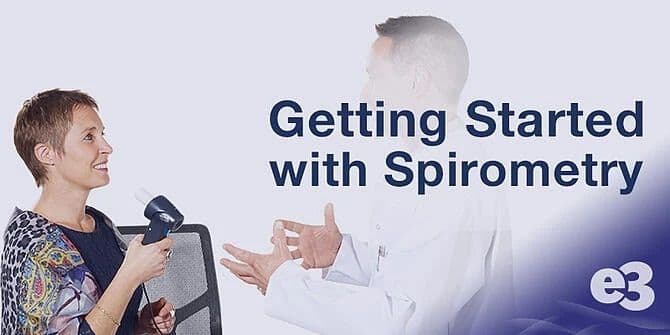Getting Started with Spirometry

Thinking about expanding your testing capabilities to include spirometry? It is a useful, reliable, and easy-to-administer test that is great for detecting early change and progression of respiratory diseases that could be caused by conditions in the work environment. However, getting started with spirometry isn’t as easy as simply buying the equipment and testing.
Read on to learn about what you need to do to successfully implement a spirometry program.
Get the Right Training
Anyone administering a spirometry test should receive training from a reputable organization. This will help them understand measures and learn how to get the best results out of the patient. Spirometric measures include:
- Forced expiratory volume in 1 s (FEV1) – Maximal amount of air that can be exhaled in one second.
- Forced Vital Capacity (FVC)/Vital capacity (VC) – Greatest volume of air that can be expelled from lungs after taking the deepest possible breath.
- FEV1/FVC ratio – Measure proportion of FEV1 to FVC. Used in the diagnosis of obstructive and restrictive lung disease.
- Peak expiratory flow (PEF) – Maximal flow that can be exhaled when blowing out at a steady rate
- Forced expiratory flow – Also known as mid-expiratory flow, it measures the speed of air coming out of the lung during the middle of a forced expiration.
- Inspiratory vital capacity (IVC), the maximum amount of air that can be inhaled after a full expiration
Not only do you need to know these measures, you need to know how to interpret them. This means being able to know the difference between what’s normal and what’s abnormal. Additionally, you need to know how to position the patient for specific measurements, how to perform specific techniques for better results, how to ensure sanitary testing conditions, and much more.
Get the Right Spirometer
Having the knowledge and training is one thing. Now you need the right equipment. There are a number of spirometers available – from portable, handheld devices to larger, stationary units. Many measure flow directly by using pneumotachographs, turbines, and other technology and calculate volume. The wedge-bellows spirometer does the opposite by measuring volume directly and calculating flow.
In the past, larger spirometers were seen as more stable, but recent technological advancements have led to the development of handheld devices that store flow-volume loops, have built-in quality control, and capture all spirometric measurements. Some can even print reports without connection to a computer and interface seamlessly with your existing EMR system.
One of these handheld devices is the Depisteo Spirometer Q13. Designed specifically for occupational health and preventative medicine, this spirometer is a complete device for measuring lung capacity. Leveraging its SpiroWin Expert softwazre, it meets and exceeds ATS/ERS and NIOSH recommendations. Additionally, it seamlessly integrates with most EMR software packages, so you can easily and efficiently transfer and store test data.
Additional features and benefits include:
- Single-use Fleisch sensor
- Does not require calibration
- No cross-contamination
- Suitable for use for SSA disability and OSHA Spirometry
- BTPS adjustment
- 2-year warranty
- Qflow sensors – 50 or 200 per box
Make Sure Your Spirometer is Calibrated
As with most medical devices, a spirometer must be calibrated to ensure accurate results. Before performing a test, you can check the calibration yourself. Depending on the equipment, you can either use a 3-L syringe to check that the meter is reading correctly, or a 1-L syringe that is pumped a liter at a time to a maximum of 7-L to check the linearity and center point of volume measurement. There are some spirometers that also allow linear calibration so the volume can be checked at different flows.
Some handheld devices, such as the Depisteo Spirolyser Q13, do not require calibration. This saves you time and money that would be spent calibrating yourself or paying a technician to do so. However, even though these devices do not require calibration, it is still wise to check their spirometric values on a weekly basis by testing a healthy subject as a control.
For more information on spirometry or to learn more about the Depisteo Spirolyser Q13, get in touch with your local e3 office today!
